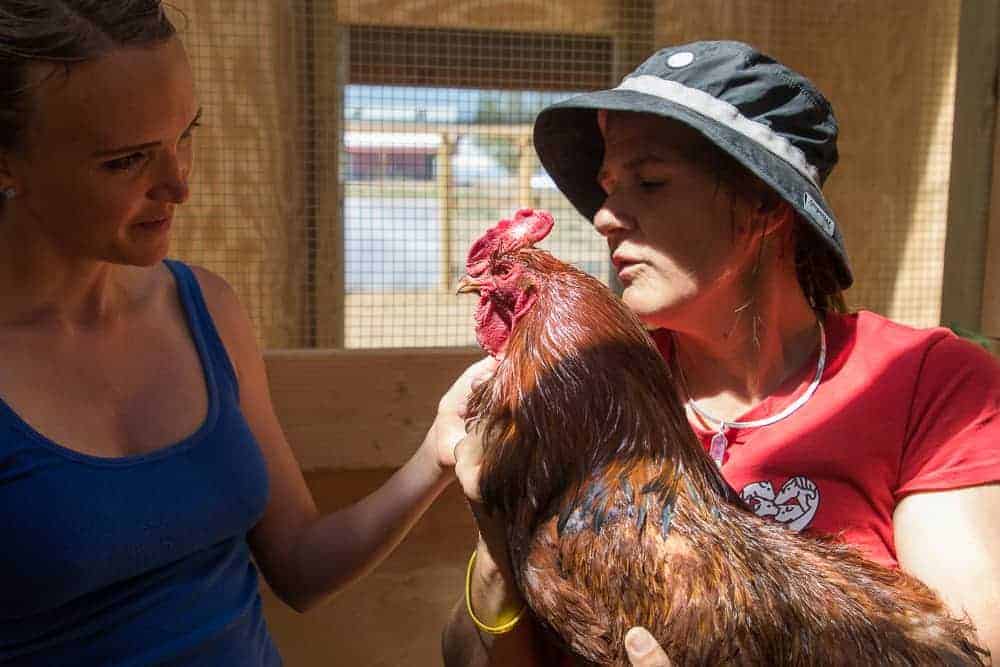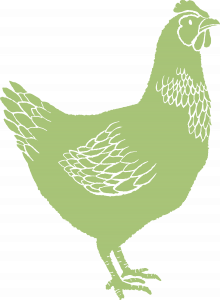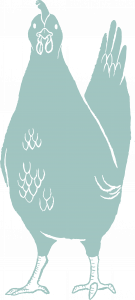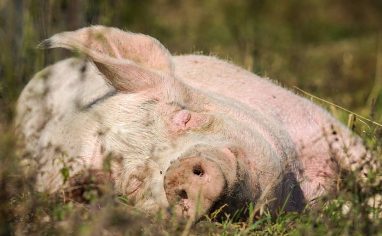
This resource has been updated as part of the veterinary review process. It was originally published on February 28, 2018.

Veterinary Review Initiative
This resource has been reviewed for accuracy and clarity by a qualified Doctor of Veterinary Medicine as of June 5, 2023. Check out more information on our Veterinary Review Initiative here!
Much like the common advice given to humans, it’s important to regularly evaluate the health of chickens with a routine health checkThe Open Sanctuary Project uses the term "health check" to describe health evaluations performed by caregivers who are not licensed veterinarians. While regular health checks are an important part of animal care, they are not meant to be a replacement for a physical exam performed by a licensed veterinarian. rather than waiting until a bird is showing signs of distress or illness. Conducting regular health checks will help you get to know what all aspects of a healthy chicken look and feel like and will also help you to establish a baseline for what is “normal” for each individual in your care. Not only this, but regular handling may help residents become more comfortable with restraint and human handling. Be prepared to check chickens over at least once a month*! For more information on why regular health checks are important, check out our resource here.
*A Monthly Health Check Means Daily Observations!
Our recommendation to conduct routine health checks monthly must be done in conjunction with daily observations. Caregivers should be trained to observe animals both for behaviors that are abnormal for the species and also behaviors that are abnormal for each individual, keeping in mind issues that are common in a particular species or breed and their warning signs. Thoughtful observation plays a crucial role in catching health issues before they progress into more serious situations. You can read more about daily observation for chicken health and well-being here.
Residents With Challenging Backgrounds
Close daily observation can be difficult with certain individuals or groups who come from challenging backgrounds. They may be more likely to hide signs of illness or injury, or may not allow you to come close enough to them to thoroughly assess their well-being on a regular basis. Challenging backgrounds may include individuals who are not socialized, have lived feral, or were abused or malnourished. If you care for individuals who came from a challenging background, it is imperative to make time to foster a bond of trust so careful observation is possible. More frequent health checks may be necessary for these individuals until they exhibit signs that they feel safe and you are confident that close daily observation is possible.

New Resident? Conduct An Intake Evaluation!
If you are conducting an initial health evaluation on a new resident, check out our intake evaluation resource to learn about what you should check for and document!
Supplies
Before conducting a health check, it’s helpful to gather any supplies you may need and have them arranged nearby for easy access. Having everything you will likely need nearby can make the process go more smoothly and can reduce the amount of time the chicken needs to be restrained. If you are performing a health check on someone with a known health issue, such as bumblefoot, you may need other supplies, like those needed to wrap a foot. Otherwise, supplies to have on hand during chicken health checks include:
- Recordkeeping supplies
- Nail trimmers and/or dremel tool
- Styptic powder or other blood stop product
- Gauze squares (non-sterile is typically fine, but there may be times when sterile gauze is necessary)
- Exam gloves
- Bandage scissors
- Silicone nail covers and provided glue (if planning to keep your rooster residents’ spurs covered)
- Chicken-safe topical disinfectant (such as dilute chlorhexidine or dilute betadine)
- Saline flush
- Chicken-safe ointments or creams such as a triple antibiotic ointment or silver sulfadiazine cream 1% (SSD)
- Cotton-tipped applicators
- Tweezers
- Scale
- Headlamp, penlight, or flashlight
- Towels
- Antiparasitic treatment for external parasites, per your veterinarian’s recommendations
Conducting The Health Check
Ask An Expert
Prior to regularly conducting chicken health checks, you should have a veterinarian or compassionate care expert give you hands-on training in order to be the best chicken health advocate possible. Being trained to rapidly distinguish abnormalities from normal anatomy and healthy conditions can be crucial in early health problem detection, and the sooner you are able to bring concerns to your veterinarian, the sooner they’ll be able to work towards making a diagnosis and recommending any necessary interventions!

Before beginning the actual health check, it’s a good idea to observe the individual without restraining them. Take note of their behavior, activity level, general appearance, how they are standing, and how they are moving. You can read more about “normal” versus potentially concerning chicken resident observations here.
During regularly scheduled health checks, your goal is to check the chicken’s whole body in a systematic order. It’s helpful to have a general order and routine that you follow each time because this can help ensure you do not miss a step. However, because some areas naturally flow into others, it might not be helpful to think of the process as a linear list of areas to check. Instead, we think of it more as a choreographed routine, where checking one area flows into checking another area. By checking individual areas or body parts in isolation, you may miss important findings in the gray areas in between. You should find a system that works for you, but we like starting at the feet and working our way up the legs, then towards the tail, and then up to the head, focusing on specific areas. Then we work our way back down towards the tail, checking the chicken’s skin and feathers on the rest of their body before rotating them so we can more easily check their other side. It’s imperative that you continually monitor how the chicken is doing by watching their breathing and their color and taking a break if they appear overly stressed.
Safe Restraint
Before attempting to conduct a health check, make sure you know how to safely hold a chicken. You can read more about safe restraint here. You must be very cognizant of a chicken’s stress levels and breathing when handling them. If a chicken ever seems to be very distressed, breathing heavily, turning dark in the comba fleshy crest on the head of the domestic chicken and other domesticated birds and wattles, or cannot breathe comfortably, you must put them down and let them rest. If you are familiar with general chicken restraint, but have never restrained a large breedDomesticated animal breeds that have been selectively bred by humans to grow as large as possible, as quickly as possible, to the detriment of their health. chicken, be aware that they may become stressed more easily and may need to be restrained in an upright position.
When In Doubt…
Unless you are a qualified veterinarian or have been trained to handle specific conditions, The Open Sanctuary Project strongly advocates that you promptly report any concerns you find during the course of a health check to your veterinarian (if you aren’t sure if what you are seeing is cause for concern or not, a more experienced caregiverSomeone who provides daily care, specifically for animal residents at an animal sanctuary, shelter, or rescue. may be able to help you, but if you are ever in doubt, we recommend erring on the side of caution and reaching out to your veterinarian). You should be the resident’s advocate, not their doctor! Additionally, routine health checks performed by a caregiver are not meant to be a replacement for a veterinary exam. The goal is to catch potential signs of concern as early as possible so you can bring concerns to your veterinarian. If necessary, they can then perform a more in-depth physical examination of the individual and can conduct diagnostic testing as needed.
Up next, we’ll go over important components of a chicken health check:
Check for any bumps, lumps, swelling, scabs, cuts, or pressure sores on both the top and bottom of the chicken’s feet and toes. Early signs of bumblefoot include the skin on the foot pad becoming smooth, shiny, and/or red, so look closely for any of these signs. Individuals with heat, swelling, scabbing, or discharge should be evaluated by a veterinarian. Don’t remove scabs unless you have been instructed to do so by a veterinarian! If you find a scab covering a swollen and hot or fluid-filled area, or if there is discharge seeping out from the scabbed area, you should have the chicken evaluated by a veterinarian as soon as possible.
In cold climates, red and swollen toe tips, blackened skin, or hard black scabby toe tips could be a sign of frostbite. If you suspect frostbite, be sure to move the chicken into a warmer area and consult with your veterinarian. At the very least, the chicken will likely require pain medications, but may need antibiotics, or even surgical intervention, depending on the extent of the damage. If a chicken shows signs of frostbite, be sure to make changes to their living spaces to protect the rest of your residents.
While bulges on the top of the foot, in between the toes, could be a sign of infection, it could also be the result of dirt or mud packed into foot crevices, which is not an uncommon occurrence in large breed chickens. If you find a resident with a lump in this area, you can start by applying very light pressure to the skin on the top of their foot while watching the bottom of the foot, which should allow you to determine if the cause of the lump is mud pack or not. Remove any mud that has become trapped in this crevice with gentle pressure and the use of wet gauze or cotton-tipped applicators. Be very careful not to damage the skin while attempting to clean this area.
Make sure that the chicken’s toes are elongated and straight – twisted and folded toes are generally not a good sign, but you’ll need to familiarize yourself with what is normal for each individual. Some chickens may come in with bent toes when they are rescued, possibly from an old injury, and may never have issues or need any treatment, but if a chicken had straight toes last month and twisted toes this month, then you should consult with a veterinarian. Also be aware that a chicken with severe arthritis may slowly develop twisted toes over time.
Don’t be alarmed if one of your residents has an extra toe – certain chicken breeds, including Dorkings, Faverolles, Houdans, Sultans, and Silkies, have five toes, with an extra toe that grows above the hallux toe (back toe) with an upward curve. This toenail will never touch the ground and may need frequent trimming.
The chicken should have smooth and non-raised scales on their feet. Raised scales could be a sign of scaly leg mites, though sometimes older individuals, especially large breed roosters, may develop slightly raised scales where their foot and the front of their leg meet.
You can check a chicken’s natural perching reflex on both feet by placing a finger under their foot and allowing the chicken to grasp it with their toes.
Check their nails to ensure that they’re at a normal length. You may have to trim or file them if overgrown.
Check for any signs of irritation on the hock1: the tarsal joint or region in the hind limb of a digitigrade quadruped (such as the horse) corresponding to the human ankle but elevated and bending backward 2: a joint of a fowl's leg that corresponds to the hock of a quadruped, which could be the beginning of a pressure sore. This is especially common in chickens who spend more time lying down due to mobility issues or obesity. These individuals may benefit from more frequent checking of their hocks. Early detection, when skin is irritated but not yet wounded, is imperative because once pressure sores develop, they are difficult to address and can lead to infection. In addition to working with a veterinarian to determine the cause and best course of action to address sores, environmental changes should be made to prevent hock sores from worsening. This includes providing softer, cushioned surfaces and/or adding more bedding to the areas where they spend time lying down.
Carefully check their range of motion, especially in their hocks, and check for crepitus (creaking, cracking, crunching, popping, or grating), pain, resistance, heat, or swelling. Stop your evaluation and contact a veterinarian immediately if you feel a large amount of crepitus with pain – this could indicate a fracture and could be made worse with ongoing manipulation. Because of the conformation of their legs, assessing range of motion issues in their knees and hips is difficult. Hot, swollen, or scabby joints could be a sign of infection. Consult with your veterinarian immediately. Never attempt to drain infected joints!
If the chicken has a leg band, check that it fits properly and is not causing any issues.
Most roosters (and some hens) have spurs, which are horny growths on the lower back part of their legs. These can grow long, just like nails and should be trimmed or filed as needed.
Look for signs of mites, lice, maggots, or other parasites. Check for wounds, especially rat wounds, as this is where they tend to bite; the presence of rat wounds is a major red flag that you must take immediate steps to control your rodent population and protect your residents before they cause more damage. Read more about compassionate ways to respond to rodent-related issues here. You may need to move chickens to a new location, such as inside your home, for the time being in order to keep them safe.
Make sure the vent isn’t irritated and that there is no prolapsed tissue. A prolapsing chicken should be set down immediately. In many cases, if there is just a small amount of prolapsed tissue, it may go back in once the chicken is put down, with no intervention on your part. If this is not the case, or if there is more than just a very small amount of tissue prolapsed or if the prolapsed tissue appears unhealthy, contact your veterinarian for guidance. Not only can they help with addressing the prolapsed tissue, they can also perform diagnostics to determine the cause of the prolapsethe falling down or slipping of a body part from its usual position or relations. Depending on the type of prolapse and cause, the stress of handling may make things worse. Because of this, it’s safest to use a carrier to move a chicken with a prolapse so as to avoid further handling (this is especially true for bigger chickens). If the chicken must be carried, keeping one hand firmly under their vent can be helpful. If a large amount of tissue is prolapsed, KY Jelly can be applied to the tissue to help keep it lubricated and potentially viable during the time it takes to transport them to the veterinarian.
Anyone with feces-covered feathers should be cleaned and/or have the dirty feathers trimmed using blunt-tipped scissors. This must be done carefully to ensure you do not accidentally cut their skin. It’s good practice to always evaluate a hen’s abdomen if you find that they have fecal matting under their vent, as this can be the result of a distended abdomen. Be sure to contact your veterinarian if anyone has excessive fecal matting, diarrhea, or is showing other signs of concern.
Non-Large BreedA domesticated animal breed that has not been specifically engineered to grow as quickly as possible for the purpose of human consumption. In resources at The Open Sanctuary Project, "Heritage" breeds of turkeys, for instance, are "non-large breed", even if they are physically quite big. Roosters
Non-large breed roosters should have a very small abdomen that does not extend out past the vent at all. It should feel soft and, with the exception of the gizzardthe muscular enlargement of the digestive tract of birds that has usually thick muscular walls and a tough horny lining for grinding the food and when the crop is present follows it and the proventriculus near the end of the keel, you should not be able to feel any defined structures. A rooster with a distended, hard, or fluidy belly should be evaluated by a veterinarian as soon as possible, as they could have a serious issue such as heart failure or cancer.
Non-Large Breed Hens
Because of the prevalence of reproductive issues in hens, you will want to pay extra attention to their abdomen, even if they are routinely implanted. It can take time to become familiar with what a “normal” hen’s abdomen feels like, and to further complicate things, an actively laying hen’s abdomen size often changes with the season, becoming more distended in the early spring when they begin to lay, and becoming smaller in the late fall/early winter when egg laying slows down. These nuances can take time to become familiar with, so be sure to take good notes during each health check, and review significant findings with your veterinarian or another care expert.
When checking their abdomen, be gentle. There is a chance someone could have a fully shelled egg in their oviduct, and you do not want to break it! Hens who are not laying (due to implantation, age, or season), should have a small abdomen, like a rooster’s. A hen who is currently laying may have an abdomen that is slightly distended and soft. A chicken’s abdomen should never feel fluidy and, with the exception of an egg and possibly the gizzard, you should not be able to feel any distinct structures. A tight, fluidy abdomen could indicate a serious health issue like egg yolk peritonitis, reproductive tract cancer, or heart failure. Hard, movable masses or a distended belly that is rock-hard could be indicative of an impacted oviduct. If you feel thick or hard nodular structures that extend back into the chicken’s body, you could be feeling unhealthy intestines resulting from an infection or cancer.
In some cases, hens bred for heavy production may develop a pendulous abdomen. Rather than being distended outward and beyond the vent, a pendulous abdomen hangs straight down and is typically very soft. This could be the result of a hernia or weakened muscles from constant egg laying. Your veterinarian can help determine if the issue is concerning or is simply the hen’s new normal. Hens with pendulous bellies can go on to develop reproductive tract issues, so it is important to continue to monitor their abdomen for any further changes.
Large Breed Chickens
Compared to the abdomen of a non-large breed chicken, large breed individuals tend to have a semi-firm (but not hard) and slightly distended abdomen. Because of this, it can be more difficult to evaluate a large breed chicken’s abdomen for signs of concern. As with non-large breed chickens, be gentle when checking their abdomen, and keep in mind that it is possible that a hen could have a fully shelled egg in her oviduct. While some non-large breed hens may be more at risk of certain reproductive diseases, keep in mind that any female chicken, including large breed hens, can develop reproductive issues. Contact your veterinarian if you note that anyone has a fluidy, tight, or rock-hard abdomen; an abdomen that is larger than normal; if you detect masses or nodular structures in the abdomen; or if someone has an abdomen that is not uniform in shape or has an area that bulges out past the rest of the abdomen. Abnormalities in the abdomen could indicate various health issues including heart or reproductive tract issues.
An enlarged preen gland could indicate impaction or cancer. Impaction can often be handled with a warm compress periodically applied to their preen gland, but the individual should be evaluated by a veterinarian before beginning treatment. Using pressure to express a preen gland that appears large can result in damage – this is a technique that should be demonstrated to you and should only be used when a veterinarian has assessed that the cause of the enlargement is indeed an impaction and not something else.
The chicken’s wings should be checked for cuts, swelling, and other injuries. If their wing tips are scabby or beat up, this could indicate they have a mobility issue and are using their wings for balance and support. Make sure to check the area underneath their wings for lice and mites, as well as any injuries – this is a common place to find mounting wounds on hens. If you find mounting wounds, be sure to investigate the cause after addressing the wounds. Sometimes, a mounting wound is a sign that the rooster the hen is living with needs to have his spurs trimmed or covered. Other times, it could be a sign that the rooster is too big or too rough for the hen or that you need to increase the hen-to-rooster ratio. If a large breed hen is getting mounting wounds, this likely means that the rooster she is living with is too large (you can read more about safe flock arrangements for large breed chickens here).
In general, the keel should not be curved, which may indicate a nutritional deficiency. While a misshapen keel is technically “abnormal”, it is not uncommon in hens bred for heavy egg production – during periods of heavy egg laying, their bodies can become depleted of calcium, causing the keel bone to soften. Depending on the hen’s environment, it can re-harden in an abnormal shape. Hens rescued from battery cages often have curved and misshapen keel bones because the bone re-hardens while the hen is lying on a wire bottom floor.
Check along the keel for any sores. Keel sores should be treated early on, before they risk infection, and you should investigate the cause (for example, are they down more often because of a mobility issue?). Mature large breed chickens typically have a featherless strip of red skin that runs along their keel and to their vent. Because this entire area is red, looking for early signs of irritation can be difficult. However, skin that is drier or flakier than the rest of the exposed skin could be an early warning sign.
If a chicken is laying eggs and crushing them while nesting, you must be diligent about keeping them clean, as egg material will attract flies, which can lead to flystrike.
If the crop is hard or filled with fluid, this could indicate a problem. In general, it is best to assess the chicken’s overall well-being in addition to any perceived crop abnormalities. A chicken could have a hard crop because they overate or didn’t drink enough water on a hot day. They could have a fluidy crop because they just drank a bit of water. If the chicken is bright and active and doesn’t have a major abnormality, you can usually plan to check the chicken’s crop later in the day and, if necessary, again in the morning before they have eaten. If their crop is flat by morning, then most likely there was never really an issue to begin with or the issue was minor and resolved on its own. If the abnormality does not resolve, becomes more severe, or the chicken begins to display other signs of illness, then you should consult with a veterinarian.
Be very careful when handling a chicken with a large fluid-filled crop, as they can easily regurgitate and then aspirate (inhale the regurgitated fluid into their airways). If the chicken has foul or sour-smelling breath, this also indicates possible crop issues (such as sour crop, which is a fungal yeast infection that requires treatment). If the crop remains full and firm and they haven’t eaten in a while (or overnight), the crop could be impacted (or blocked). You may find that a chicken’s crop is mostly emptying its contents, but notice a small clump of something that remains in the crop for days. In these cases, there may be plant matter, feathers, or other indigestible materials in the crop. Consult with your veterinarian – in some cases surgical intervention is necessary.
NEVER attempt to empty a chicken’s crop by following backyard chickenThe raising of chickens primarily for the consumption of their eggs and/or flesh, typically in a non-agricultural environment. recommendations to cut into the crop or force them to regurgitate. These are not safe or appropriate practices. Emptying the crop using a feeding tube and syringe should only be done by a professional or highly trained chicken caregiver, and the chicken’s crop must first be evaluated to determine if the contents can be removed in this manner. In some cases, surgery is necessary. All surgical interventions must be done by a licensed veterinarian using proper analgesics and anesthetics. Discuss all crop issues and treatments with your veterinarian – it’s important to determine the underlying cause of the crop issue which often requires a culture and possibly diagnostic imaging.
Keep in mind that while a chicken can develop a primary crop issue, and these can be particularly common in large breed chickens, in non-large breed hens, crop issues are often secondary to a reproductive tract issue. Always check the abdomen of a hen with crop motility issues, and discuss the possibility of reproductive tract issues with your veterinarian.
Comb and Wattles – Unless normal for the breed/individual, a chicken’s comb should not be floppy, and the comb and wattles should not be shriveled, swollen, pale, ashen, or discolored from their normal hue. Look for any scabbing, which could be a sign of illness (such as dry fowl pox) or injury. If you find that the tip of the comb or the bottom of their wattles are discolored, swollen, oozy, or scabby, this could be a sign of frostbite.
Ears – They should have clean feathers covering their ears and the canal be free of discharge or debris.
Eyes – The chicken should have wide open, clean, alert eyes. They should be clear and free of discharge. Cloudy, watery, dry, swollen, or crusty eyes could indicate illness or injury. Their pupils should be round, be about the same size, and react properly to bright light (get smaller and then return to normal). A misshapen or gray pupil could be a sign of Marek’s disease, and a cloudy eye could be a cataract or the result of an infection. A bulging eye could be caused by glaucoma. You should have your veterinarian evaluate any eye abnormalities as soon as possible. Chickens have a third eyelid (also known as the nictitating membranea thin membrane found in many vertebrates at the inner angle or beneath the lower lid of the eye and capable of extending across the eyeball). It should be cloudy white and retract when stimulated, rather than red, swollen, or non-retractable.
Sinuses – Check the area around the eyes and in front of the eyes for any swelling.
Beak – Their beak should be smooth and free of cracks. In chickens who have not been debeaked, check if the top beak needs to be trimmed. If their upper beak begins to grow much longer than their lower beak, it can interfere with eating, pecking, and preening. Check the alignment of their upper mandible (top part of their beak). It should be directly above the bottom part and, unless they have been debeaked, should be slightly longer, usually coming to a point. If the top and bottom beak go in different directions, this is referred to as “scissor beak” or “cross beak” and is often the result of a congenital issue. Chickens with a crossed beak may need to be offered softer foods (such as soaked pellets) in a wide shallow bowl, because dry pellets and crumble can be difficult for them to eat. They also tend to need their beaks trimmed regularly, and, depending on the severity, may need either or both their upper and lower beaks trimmed. If you notice that a chicken’s beak alignment is suddenly different, consult with your veterinarian.
Nareseither of the pair of openings of the nose or nasal cavity – There shouldn’t be any discharge or crustiness in their nares. If the nares appear clogged at all, you can use a moistened cotton-tipped applicator or a pair of tweezers to gently remove any obstruction. Their breathing should not be labored, loud, wheezy, rattly, whistling, or squeaky.
When you look inside their mouth, it should not be tacky or have excessive mucus. A sticky or tacky mouth could be a sign that the chicken is dehydrated. Their mouth should not have any ulcers, lesions, lumps, or areas of discoloration. Raised yellow lesions could be a sign of wet pox, squamous cell carcinoma, or another disease. It’s completely normal for their mouth’s roof and upper mandible to have a split in it. This is the choanal slit, and it should be free of obstruction and discharge. Their breath shouldn’t have an overly strong odor – a sour smell could be a sign of sour crop. At the center of the back of their throat is the glottis (the opening to the trachea), and depending on the lighting and the angle from which you are looking, you may also be able to see partially down their trachea. If you have a concern about the trachea, in addition to consulting with your veterinarian, you can hold a light against the chicken’s neck while looking down their throat. The light will illuminate their trachea, allowing you to see more clearly for any signs of obstruction, gapeworms, lesions, or other concerns.
Part the chicken’s feathers around their body, being mindful of pin feathers, as these emerging feathers are very sensitive to handling and can be damaged easily. Feathers can hide skin illnesses and injuries. This is the time to ensure you are checking and feeling every area of the individual’s body, not just those highlighted above. This thorough portion of the health check is critical to ensure that nothing that can be addressed early is missed. Look for areas of discoloration, scabbing, swelling, and any signs of injury. Look carefully for any signs of external parasites, including clumps of eggs or irritated, scabby skin. Their skin should be pale pink and translucent unless they are a breed with naturally darker skin, such as a Silkie or Ayam Cemani. Their skin should also typically be soft and smooth. However, keep in mind that in large breed chickens, particularly Cornish crosses, the area along the keel and on the abdomen is often thicker and redder than the rest of their skin.
To weigh chicken residents, it can be helpful to use a scale intended for “dynamic weighing” or “weighing in motion,” as these scales will calculate the average weight for an animal moving around on the scale rather than oscillating indefinitely. Make sure the chicken has adequate traction on the scale (a bath mat or rubber bowl can be used to provide traction) and keep your hands near them to prevent them from slipping or jumping off and injuring themselves. We recommend weighing chickens in a standing or sitting position, though non-large breed chickens may be able to be placed on their side. We don’t recommend placing any chicken on their back since some may have a severe adverse reaction to being in this position.
In addition to weighing each individual, you should also pay close attention to their body condition to determine if they are at a healthy weight. For large breed chickens, in particular, their body condition will help you determine if their diet needs to be adjusted, as each individual will have their own ideal weight range. Also keep in mind that some health conditions, such as reproductive issues, could result in an individual having a seemingly healthy weight based on the number on the scale, but a check of their body condition may reveal emaciation.
When in doubt, grab a fecal sample and connect with your veterinarian.
To read more about considering alternative living arrangements in response to a health condition, check out our resource here.
Though it may seem like an overwhelming amount of factors to be aware of, once you’ve gotten to know a chicken and what good chicken health looks like, you’ll be an excellent chicken health ally in no time!
Writing It All Down
As you may know, regular documentation is a critical part of responsible sanctuary animal care. In order to maximize the value of your chicken health checks, we’ve developed a free printable chicken health check form for sanctuaries and rescues!
SOURCES:
Physical Exam One Page Guide | Chicken Run Rescue
Physical Examination Of Backyard Poultry | The Merck Vet Manual
DIY Chicken Checkup | The Chicken Chick (Non-Compassionate Source)
Chicken Poop Guide | The Chicken Chick (Non-Compassionate Source)
Non-Compassionate Source?
If a source includes the (Non-Compassionate Source) tag, it means that we do not endorse that particular source’s views about animals, even if some of their insights are valuable from a care perspective. See a more detailed explanation here.








